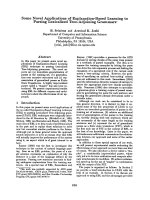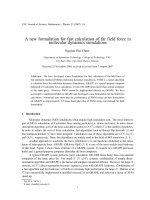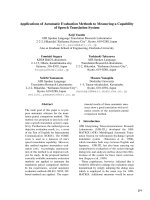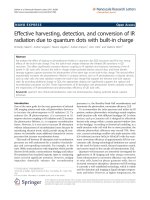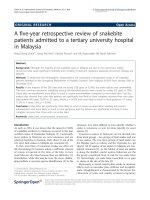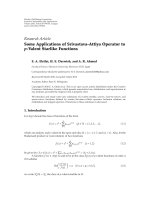Applications of finite field computation to cryptology extension field arithmetic in public key systems and algebraic attacks on stream ciphers
Bạn đang xem bản rút gọn của tài liệu. Xem và tải ngay bản đầy đủ của tài liệu tại đây (1023.88 KB, 201 trang )
Applications of Finite Field Computation
to Cryptology: Extension Field
Arithmetic in Public Key Systems and
Algebraic Attacks on Stream Ciphers
Kenneth Koon-Ho Wong
Bachelor of Applied Science (First Class Honours)
Queensland University of Technology, 2003
Thesis submitted in accordance with the regulations for the
Degree of Doctor of Philosophy
Information Security Institute
Faculty of Information Technology
Queensland University of Technology
2008
ii
Keywords
algebraic attacks, clock control, cyclotomic fields, CEILIDH, extension fields, Gauss
periods, Karatsuba multiplication, Pomaranch, RC4, stream ciphers, torus-based
cryptography, XTR
iii
iv
Abstract
In this digital age, cryptography is largely built in computer hardware or software
as discrete structures. One of the most useful of these structures is finite fields. In
this thesis, we explore a variety of applications of the theory and applications of
arithmetic and computation in finite fields in both the areas of cryptography and
cryptanalysis.
First, multiplication algorithms in finite extensions of prime fields are explored. A
new algebraic description of implementing the subquadratic Karatsuba algorithm
and its variants for extension field multiplication are presented. The use of cyclotomic fields and Gauss periods in constructing suitable extensions of virtually
all sizes for efficient arithmetic are described. These multiplication techniques are
then applied on some previously proposed public key cryptosystem based on extension fields. These include the trace-based cryptosystems such as XTR, and torusbased cryptosystems such as CEILIDH. Improvements to the cost of arithmetic
were achieved in some constructions due to the capability of thorough optimisation
using the algebraic description.
Then, for symmetric key systems, the focus is on algebraic analysis and attacks of
stream ciphers. Different techniques of computing solutions to an arbitrary system
of boolean equations were considered, and a method of analysing and simplifying
the system using truth tables and graph theory have been investigated. Algebraic
analyses were performed on stream ciphers based on linear feedback shift registers
where clock control mechanisms are employed, a category of ciphers that have
not been previously analysed before using this method. The results are successful
v
vi
algebraic attacks on various clock-controlled generators and cascade generators,
and a full algebraic analyses for the eSTREAM cipher candidate Pomaranch. Some
weaknesses in the filter functions used in Pomaranch have also been found.
Finally, some non-traditional algebraic analysis of stream ciphers are presented.
An algebraic analysis on the word-based RC4 family of stream ciphers is performed
by constructing algebraic expressions for each of the operations involved, and it is
concluded that each of these operations are significant in contributing to the overall
security of the system. As far as we know, this is the first algebraic analysis on a
stream cipher that is not based on linear feedback shift registers. The possibility
of using binary extension fields and quotient rings for algebraic analysis of stream
ciphers based on linear feedback shift registers are then investigated. Feasible
algebraic attacks for generators with nonlinear filters are obtained and algebraic
analyses for more complicated generators with multiple registers are presented.
This new form of algebraic analysis may prove useful and thereby complement the
traditional algebraic attacks.
This thesis concludes with some future directions that can be taken and some
open questions. Arithmetic and computation in finite fields will certainly be an
important area for ongoing research as we are confronted with new developments
in theory and exponentially growing computer power.
Declaration
The work contained in this thesis has not been previously submitted for a degree
or diploma at any higher education institution. To the best of my knowledge and
belief, the thesis contains no material previously published or written by another
person except where due reference is made.
Signed:. . . . . . . . . . . . . . . . . . . . . . . . . . . . . . . . . . . . . . . . . . . . Date:. . . . . . . . . . . . . . . . . . . . . .
vii
viii
Acknowledgements
The quality and quantity of the research presented in this thesis would not have
been achieved without my supervisors, Gary Carter and Ed Dawson, who have
provided me with every help, support and encouragement throughout the seemingly. They have spent numerous hours with me on suggesting research directions,
discussing problems and reviewing writings. I sincerely pay my highest regards to
their kindness and professionalism.
I have been fortunate to be able to work with many other researchers during my
research. I would like to thank Winfried M¨
uller, who warmly hosted my visit for
three weeks at the Department of Mathematics, University of Klagenfurt, Austria.
I have gained much from working with colleagues while being there. I would like
to thank Sultan Al-Hinai, Lynn Batten, Bernard Colbert, and Subhamoy Maitra,
whom I have had the honour to meet in the last few years. They have provided
me comments and suggestions to improve on various aspects of my research. In
particular, I have enjoyed the close collaboration with Sultan Al-Hinai, my fellow PhD student, as well as his supervisors, Matt Henricksen, Bill Millan and
Leonie Simpson, at the Information Security Institute. Together, Sultan and I
have achieved two joint publications, where each of us contributed in our strength
toward some nice results. The collaborative work appears in Sections 5.4-5.6 of
this thesis. I would like to also thank Lynn Batten for her organisation in making the two publications possible, and also for inviting me to speak at one of her
workshops. I would like to thank Gregory Bard and Richard Brent for providing
valuable comments that have improved some of the work contained in Section 3.3
significantly.
ix
x
My colleagues at both the Information Security Institute and the School of Mathematical Sciences, Faculty of Science have undoubtedly given me a warm atmosphere under which I can comfortably work on my research. I greatly appreciate
their friendship to me and discussions that inspire me much.
I would like to thank the Australian Commonwealth Government, Queensland
University of Technology, and the Information Security Institute for providing
generous scholarships and subsidies for my studies. I would also like to thank the
the Information Security Institute and the School of Software Engineering and
Data Communications, Faculty of Information Technology for providing me with
both the opportunities and funds for my local, interstate and overseas travels and
studies at various conferences and workshops.
I would also like to thank the internal review panel, comprising of Colin Boyd,
Gary Carter, Ed Dawson and Ian Turner, for spending time to review my thesis
and final seminar, and providing valuable comments to improve the quality of the
thesis submission.
Last but not least, I would like to give sincere appreciation the Dean’s Scholars
Program offered to me through the Faculty of Science as part of my undergraduate
studies, which has prepared me the skills and knowledge to conduct research at the
academic level, and paved my way towards the completion of a doctoral degree.
Previously Published Material
• Sultan Al-Hinai, Lynn Batten, Bernard Colbert and Kenneth Koon-Ho Wong.
Algebraic attacks on clock-controlled stream ciphers. In 11th Australasian
Conference on Information Security and Privacy - ACISP 2006, volume 4058
of Lecture Notes in Computer Science, pages 1-16, Melbourne, Australia,
2006. Springer.
• Kenneth Koon-Ho Wong, Gary Carter and Ed Dawson. Implementation
of extension field arithmetic with applications to torus-based cryptography.
In Workshop on General Algebra, AAA 70, volume 17 of Contributions on
General Algebra, Vienna, Austria, 2005. Johannes Heyn.
• Kenneth Koon-Ho Wong, Bernard Colbert, Lynn Batten and Sultan AlHinai. Algebraic analysis on clock-controlled cascade ciphers. In Progress
in Cryptology - Indocrypt 2006, volume 4329 of Lecture Notes in Computer
Science, pages 32-47, Kolkata, India, 2006. Springer.
xi
xii
Contents
Keywords . . . . . . . . . . . . . . . . . . . . . . . . . . . . . . . . . . .
iii
Abstract . . . . . . . . . . . . . . . . . . . . . . . . . . . . . . . . . . . .
v
Declaration . . . . . . . . . . . . . . . . . . . . . . . . . . . . . . . . . . vii
Acknowledgements . . . . . . . . . . . . . . . . . . . . . . . . . . . . . .
ix
Previously Published Material . . . . . . . . . . . . . . . . . . . . . . . .
xi
1 Introduction
1.1
1
Modern Cryptology . . . . . . . . . . . . . . . . . . . . . . . . . . .
2
1.1.1
Finite Field Arithmetic in Prime Fields . . . . . . . . . . . .
2
1.1.2
Algebraic Attacks in Binary Fields . . . . . . . . . . . . . .
2
Aims and Objectives . . . . . . . . . . . . . . . . . . . . . . . . . .
3
1.2.1
Extension Field Arithmetic . . . . . . . . . . . . . . . . . .
3
1.2.2
Algebraic Analysis and Attacks . . . . . . . . . . . . . . . .
3
1.3
Main Outcomes . . . . . . . . . . . . . . . . . . . . . . . . . . . . .
4
1.4
Structure of Thesis . . . . . . . . . . . . . . . . . . . . . . . . . . .
5
1.2
xiii
xiv
CONTENTS
2 Solving Equations over Finite Fields
7
2.1
Introduction . . . . . . . . . . . . . . . . . . . . . . . . . . . . . . .
7
2.2
Linear Systems . . . . . . . . . . . . . . . . . . . . . . . . . . . . .
8
2.2.1
Gaussian Elimination . . . . . . . . . . . . . . . . . . . . . .
8
2.2.2
Solution Methods over Finite Fields . . . . . . . . . . . . . .
9
Univariate Polynomials . . . . . . . . . . . . . . . . . . . . . . . . .
9
2.3
2.4
2.5
2.3.1
Polynomial Factorisation and Root Finding . . . . . . . . . 10
2.3.2
Cantor-Zassenhaus Equal Degree Factorisation . . . . . . . . 11
2.3.3
Common Roots of Univariate Polynomials . . . . . . . . . . 13
Multivariate Polynomial Systems . . . . . . . . . . . . . . . . . . . 14
2.4.1
Linearisation . . . . . . . . . . . . . . . . . . . . . . . . . . 14
2.4.2
Gr¨obner Bases . . . . . . . . . . . . . . . . . . . . . . . . . . 16
2.4.3
Truth Tables and Graphs . . . . . . . . . . . . . . . . . . . . 20
Summary . . . . . . . . . . . . . . . . . . . . . . . . . . . . . . . . 23
3 Finite Field Arithmetic
25
3.1
Introduction . . . . . . . . . . . . . . . . . . . . . . . . . . . . . . . 25
3.2
Karatsuba Multiplication . . . . . . . . . . . . . . . . . . . . . . . . 27
3.2.1
Traditional Recursive Algorithm . . . . . . . . . . . . . . . . 29
3.2.2
Generalised Recursive Algorithm . . . . . . . . . . . . . . . 31
xv
CONTENTS
3.3
3.4
3.5
3.6
Arithmetic in Extension Fields . . . . . . . . . . . . . . . . . . . . . 33
3.3.1
Polynomial Bases . . . . . . . . . . . . . . . . . . . . . . . . 34
3.3.2
Normal Bases . . . . . . . . . . . . . . . . . . . . . . . . . . 36
Cyclotomic Fields . . . . . . . . . . . . . . . . . . . . . . . . . . . . 36
3.4.1
Multiplication in Extensions of Degree 2m . . . . . . . . . . 38
3.4.2
Multiplication in Even Extensions . . . . . . . . . . . . . . . 39
Gauss Periods . . . . . . . . . . . . . . . . . . . . . . . . . . . . . . 41
3.5.1
Multiplication with Single Extensions . . . . . . . . . . . . . 42
3.5.2
Multiplication with Multiple Extensions . . . . . . . . . . . 43
Summary . . . . . . . . . . . . . . . . . . . . . . . . . . . . . . . . 44
4 Public Key Systems in Extension Fields
4.1
Introduction . . . . . . . . . . . . . . . . . . . . . . . . . . . . . . . 47
4.1.1
4.2
4.3
47
Public Key Cryptography . . . . . . . . . . . . . . . . . . . 48
Trace-Based Cryptography . . . . . . . . . . . . . . . . . . . . . . . 49
4.2.1
LUC . . . . . . . . . . . . . . . . . . . . . . . . . . . . . . . 50
4.2.2
XTR . . . . . . . . . . . . . . . . . . . . . . . . . . . . . . . 51
Torus-Based Cryptography . . . . . . . . . . . . . . . . . . . . . . . 53
4.3.1
CEILIDH . . . . . . . . . . . . . . . . . . . . . . . . . . . . 55
4.3.2
Systems Based on Higher Dimensional Tori . . . . . . . . . . 59
xvi
CONTENTS
4.4
Summary . . . . . . . . . . . . . . . . . . . . . . . . . . . . . . . . 62
5 Algebraic Analsysis of Stream Ciphers
5.1
5.2
5.3
5.4
Introduction . . . . . . . . . . . . . . . . . . . . . . . . . . . . . . . 63
5.1.1
Stream Ciphers . . . . . . . . . . . . . . . . . . . . . . . . . 64
5.1.2
Algebraic Analyses and Attacks . . . . . . . . . . . . . . . . 66
Stream Cipher Design . . . . . . . . . . . . . . . . . . . . . . . . . 67
5.2.1
Linear Feedback Shift Registers . . . . . . . . . . . . . . . . 67
5.2.2
Expressions for Register States . . . . . . . . . . . . . . . . 68
5.2.3
Expressions for Nonlinear Components . . . . . . . . . . . . 70
Algebraic Attacks . . . . . . . . . . . . . . . . . . . . . . . . . . . . 72
5.3.1
Traditional Algebraic Attacks . . . . . . . . . . . . . . . . . 72
5.3.2
Improving Algebraic Attacks . . . . . . . . . . . . . . . . . . 74
Clock Controls . . . . . . . . . . . . . . . . . . . . . . . . . . . . . 75
5.4.1
5.5
63
Algebraic Analysis of Clock-Controlled Registers . . . . . . . 77
Clock-Controlled Stream Ciphers . . . . . . . . . . . . . . . . . . . 80
5.5.1
The Stop-and-Go Generator . . . . . . . . . . . . . . . . . . 81
5.5.2
The Step-1/Step-2 Generator . . . . . . . . . . . . . . . . . 82
5.5.3
The Alternating Step Generator . . . . . . . . . . . . . . . . 85
5.5.4
The Self-Decimated Generator . . . . . . . . . . . . . . . . . 87
CONTENTS
xvii
5.5.5
The Strengthened Beth-Piper Generator . . . . . . . . . . . 89
5.6
Clock-Controlled Cascade Ciphers . . . . . . . . . . . . . . . . . . . 92
5.6.1
The Gollmann Cascade Generator . . . . . . . . . . . . . . . 94
5.6.2
Variable Relabelling . . . . . . . . . . . . . . . . . . . . . . 98
5.6.3
Pomaranch . . . . . . . . . . . . . . . . . . . . . . . . . . . 100
5.6.4
Algebraic Analysis of Pomaranch . . . . . . . . . . . . . . . 102
5.6.5
The Filter Functions in Pomaranch . . . . . . . . . . . . . . 108
5.7
Further Notes . . . . . . . . . . . . . . . . . . . . . . . . . . . . . . 110
5.8
Summary . . . . . . . . . . . . . . . . . . . . . . . . . . . . . . . . 111
6 Algebraic Analyses with Binary Fields
113
6.1
Introduction . . . . . . . . . . . . . . . . . . . . . . . . . . . . . . . 113
6.2
The RC4 Family of Stream Ciphers . . . . . . . . . . . . . . . . . . 115
6.2.1
Description of RC4 . . . . . . . . . . . . . . . . . . . . . . . 116
6.2.2
Algebraic Analysis of RC4 . . . . . . . . . . . . . . . . . . . 117
State Extraction . . . . . . . . . . . . . . . . . . . . . . . . 118
Word Addition . . . . . . . . . . . . . . . . . . . . . . . . . 119
State Permutation . . . . . . . . . . . . . . . . . . . . . . . 120
6.2.3
Equation Generation . . . . . . . . . . . . . . . . . . . . . . 122
Pointer Increment . . . . . . . . . . . . . . . . . . . . . . . . 122
xviii
CONTENTS
Pointer Addition . . . . . . . . . . . . . . . . . . . . . . . . 123
State Permutation . . . . . . . . . . . . . . . . . . . . . . . 124
Keystream Generation . . . . . . . . . . . . . . . . . . . . . 126
6.3
6.4
6.2.4
Summary of Equations in RC4 . . . . . . . . . . . . . . . . . 127
6.2.5
RC4 as an Algebraic Cipher . . . . . . . . . . . . . . . . . . 127
6.2.6
Algebraic Attacks on RC4 . . . . . . . . . . . . . . . . . . . 128
6.2.7
Section Summary . . . . . . . . . . . . . . . . . . . . . . . . 129
Extension Field Algebraic Analysis . . . . . . . . . . . . . . . . . . 129
6.3.1
Introduction . . . . . . . . . . . . . . . . . . . . . . . . . . . 130
6.3.2
Algebraic Analysis of LFSR Generators . . . . . . . . . . . . 130
6.3.3
Non-Linear Components . . . . . . . . . . . . . . . . . . . . 133
6.3.4
Extension Field Elements . . . . . . . . . . . . . . . . . . . 136
6.3.5
Multiple Registers
6.3.6
Comparison with Traditional Algebraic Attacks . . . . . . . 140
6.3.7
Section Summary . . . . . . . . . . . . . . . . . . . . . . . . 141
. . . . . . . . . . . . . . . . . . . . . . . 137
Summary . . . . . . . . . . . . . . . . . . . . . . . . . . . . . . . . 142
7 Conclusion
143
7.1
Summary of Thesis . . . . . . . . . . . . . . . . . . . . . . . . . . . 143
7.2
Future Directions . . . . . . . . . . . . . . . . . . . . . . . . . . . . 145
CONTENTS
xix
7.3
Open Questions . . . . . . . . . . . . . . . . . . . . . . . . . . . . . 146
7.4
Closing Remarks . . . . . . . . . . . . . . . . . . . . . . . . . . . . 147
A Algebraic Preliminaries
149
A.1 Abstract Algebra . . . . . . . . . . . . . . . . . . . . . . . . . . . . 149
A.1.1 Quotients . . . . . . . . . . . . . . . . . . . . . . . . . . . . 151
A.1.2 Field Theory . . . . . . . . . . . . . . . . . . . . . . . . . . 153
A.2 Number Theory . . . . . . . . . . . . . . . . . . . . . . . . . . . . . 154
A.3 Commutative Algebra . . . . . . . . . . . . . . . . . . . . . . . . . 154
A.3.1 Finite Fields . . . . . . . . . . . . . . . . . . . . . . . . . . . 156
A.3.2 Gr¨obner Bases . . . . . . . . . . . . . . . . . . . . . . . . . . 157
A.4 Ideals and Varieties . . . . . . . . . . . . . . . . . . . . . . . . . . . 159
B Tables
161
B.1 List of Cyclotomic Fields . . . . . . . . . . . . . . . . . . . . . . . . 161
B.2 List of Gaussian Normal Bases . . . . . . . . . . . . . . . . . . . . . 161
xx
CONTENTS
List of Figures
5.1
Schematic of a Stream Cipher . . . . . . . . . . . . . . . . . . . . . 64
5.2
A Bit-Based Linear Feedback Shift Register . . . . . . . . . . . . . 68
5.3
A Nonlinear Filter Generator . . . . . . . . . . . . . . . . . . . . . 71
5.4
A Clock-Controlled Generator . . . . . . . . . . . . . . . . . . . . . 76
5.5
The Stop-and-Go Generator . . . . . . . . . . . . . . . . . . . . . . 81
5.6
The Step-1/Step-2 Generator . . . . . . . . . . . . . . . . . . . . . 82
5.7
The Alternating Step Generator . . . . . . . . . . . . . . . . . . . . 85
5.8
The Self-Decimated Generator . . . . . . . . . . . . . . . . . . . . . 88
5.9
The Strengthened Beth-Piper Generator . . . . . . . . . . . . . . . 90
5.10 The Gollman Cascade Generator . . . . . . . . . . . . . . . . . . . 94
5.11 The Pomaranch Stream Cipher (Version 3) . . . . . . . . . . . . . . 101
5.12 The Pomaranch S-Box . . . . . . . . . . . . . . . . . . . . . . . . . 104
5.13 The Algebraic Normal Form (ANF) of Filter Function f
. . . . . . 105
5.14 Annihilators and Low Degree Multiples f in Pomaranch
. . . . . . 109
xxi
xxii
LIST OF FIGURES
5.15 Annihilators and Low Degree Multiples of g in Pomaranch . . . . . 110
6.1
The KSA and PRNG of RC4
. . . . . . . . . . . . . . . . . . . . . 116
6.2
A Nonlinear Filter Generator . . . . . . . . . . . . . . . . . . . . . 133
List of Tables
3.1
Cyclotomic Fields Fqn for 2 ≤ n ≤ 16 . . . . . . . . . . . . . . . . . 38
3.2
Recursive Karatsuba multiplication over cyclotomic fields Fp2m . . . 39
3.3
Traditional Recursive Karatsuba Algorithm over Fp2t . . . . . . . . 40
3.4
Generalised Recursive Karatsuba Algorithm over Fp2t . . . . . . . . 40
3.5
Gaussian Normal Bases for 2 ≤ n ≤ 7 with Least k . . . . . . . . . 42
3.6
Multiplication with Gaussian normal bases . . . . . . . . . . . . . . 43
3.7
Constructing Multiple Extensions . . . . . . . . . . . . . . . . . . . 44
4.1
Arithmetic Costs in LUC in [90] . . . . . . . . . . . . . . . . . . . . 51
4.2
Arithmetic Costs in XTR in [90] . . . . . . . . . . . . . . . . . . . . 53
4.3
Arithmetic Costs of CEILIDH in [45] . . . . . . . . . . . . . . . . . 56
4.4
Optimised Arithmetic Costs of CEILIDH . . . . . . . . . . . . . . . 57
4.5
Cost of Karatsuba Arithmetic in Fp6
4.6
Arithmetic Costs in the T30 System in [94] . . . . . . . . . . . . . . 60
4.7
Optimised Arithmetic Costs in the T30 System . . . . . . . . . . . . 60
xxiii
. . . . . . . . . . . . . . . . . 59
xxiv
LIST OF TABLES
4.8
Primitive Arithmetic Costs in the T210 System . . . . . . . . . . . . 61
4.9
Towered Arithmetic Costs in the T210 System
5.1
Comparison of Attack Complexities on the Step1/Step2 Generator . 84
5.2
Attack Times for the Step1/Step2 Generator . . . . . . . . . . . . . 84
5.3
Comparison of Attacks on the Alternating Step Generator . . . . . 87
5.4
Algebraic Attack Times for the Alternating Step Generator . . . . . 87
5.5
Attack Complexities on the Self-Decimated Generator . . . . . . . . 89
5.6
Algebraic Attack Times on the Self-Decimated Generator . . . . . . 89
5.7
Comparison of Attacks on the Strengthened Beth-Piper Generator . 92
5.8
Attack Times for the Strengthened Beth-Piper Stop-and-Go Generator . . . . . . . . . . . . . . . . . . . . . . . . . . . . . . . . . . 92
5.9
Comparison of Attack Complexities on the Gollmann Cascade Generator . . . . . . . . . . . . . . . . . . . . . . . . . . . . . . . . . . 98
6.1
Summary of Equations Generated for RC4 . . . . . . . . . . . . . . 127
6.2
Algebraic Attacks on the Filter Generator . . . . . . . . . . . . . . 136
. . . . . . . . . . . . 61
B.1 Cyclotomic Fields for 2 ≤ n ≤ 88 . . . . . . . . . . . . . . . . . . . 162
B.2 Gaussian Normal Bases for 2 ≤ n ≤ 14 . . . . . . . . . . . . . . . . 163
Chapter 1
Introduction
As we know it today, cryptology primarily deals with discrete structures and algebraic manipulations inside hardware and software. Finite fields are well-studied
discrete structures with a vast array of useful properties and are indispensable in
the theory and application of cryptology. Efficient computation in finite fields is
crucial for the feasibility of cryptographic systems built on them, and also for the
successful cryptanalyses of such systems. Research progress in the arithmetic and
computation in finite fields with a view to improving cryptological processes is
constantly being made. This thesis intends to become part of the endeavour to
analyse more deeply and improve on cryptology over finite fields.
The theory and applications of arithmetic over finite fields have been a major
research area, particularly since the advent of public key cryptography. Recently,
public key systems based on extension fields have been proposed. In this thesis,
we present a structural analysis of extension field multiplication, in an attempt to
achieve the most optimised algorithm based on Karatsuba arithmetic.
In relatively recent times, a powerful new technique has been added to the cryptanalysis arsenal. Algebraic analysis, as it is known, essentially represents what
is happening inside a cryptosystem as a system of equations and then proceeds
to solve these equations to reveal the keys or initial states of the system. In this
1

